
Magic Carpet is a 3D flying video game developed by Bullfrog Productions and published by Electronic Arts in 1994. Its graphics and gameplay were considered innovative and technically impressive at the time of its release.

Resident Evil is a 1996 survival horror game developed and published by Capcom for the PlayStation. It is the first game in Capcom's Resident Evil franchise. Players control Chris Redfield and Jill Valentine, members of the elite task force S.T.A.R.S., who must escape a mansion infested with zombies and other monsters.
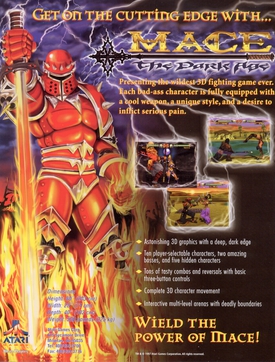
Mace: The Dark Age is a fighting video game released by Atari Games for arcade machines in 1997 and later ported by Midway to the Nintendo 64. Like many fighting games of the time, its style is marked by extreme violence, with characters graphically slaying defeated opponents. Utilizing 3Dfx Voodoo chips for the hardware, the game received attention for its cutting-edge graphics and turned Atari a profit in the arcades. Critical response to the gameplay was much less enthusiastic.
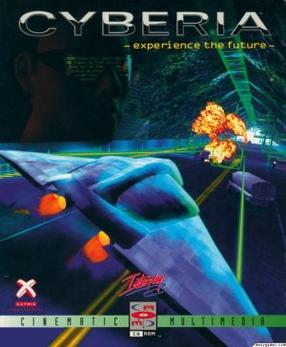
Cyberia is a science fiction action adventure video game released for MS-DOS in January 1994, and released two years later on the PlayStation, Sega Saturn, 3DO and FM Towns consoles. A sequel, Cyberia 2: Resurrection, was released in 1995 for both DOS and Windows 9x formats.
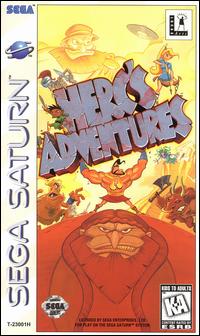
Herc's Adventures is a video game released for the PlayStation and the Sega Saturn by LucasArts in 1997. The overhead, action-adventure format is similar to Zombies Ate My Neighbors. Up to two players each take on the role of one of three ancient Greek heroes: Herc (Hercules), Atlanta (Atalanta), or Jason, who are on a quest to defeat Hades and save the goddess of nature, Persephone. In 2014, it was released for PSN in North America.
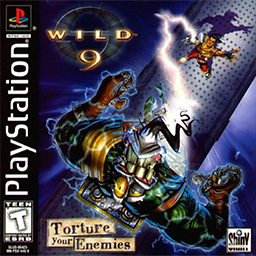
Wild 9 is a 2.5D platform video game for the PlayStation. The game was designed by David Perry, developed by Shiny Entertainment, and published by Interplay Productions; all of which were parties involved in Earthworm Jim series of video games. The game was released in North America and Europe in September 1998.
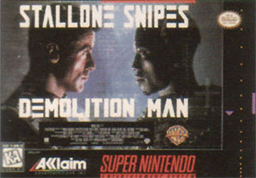
Demolition Man is a pair of action video games based on the film of the same name. Acclaim Entertainment published the 16-bit version, which features run and gun gameplay, for the Super NES, Sega Genesis and Sega CD. Virgin Interactive released a completely different game for the 3DO that combined several distinct gameplay styles. In both games, the player controls John Spartan, the main character from the film, as he attempts to find and defeat his nemesis, Simon Phoenix.

Road & Track Presents: The Need for Speed is a racing video game developed by EA Canada, originally known as Pioneer Productions, and published by Electronic Arts, released for the 3DO in 1994, and ported to MS-DOS in 1995. Another version of the game, The Need for Speed: Special Edition, was released in 1996 for the Microsoft Windows, PlayStation, and Sega Saturn platforms. The original 3DO version offers eight sports cars, including several exotic models and Japanese imports, and tasks the player with racing in three realistic point-to-point tracks either with or without a computer opponent. Subsequent ports of the game normally include an additional ninth car and have more tracks, including closed circuits. Checkpoints, traffic vehicles, and police pursuits commonly appear in the races.
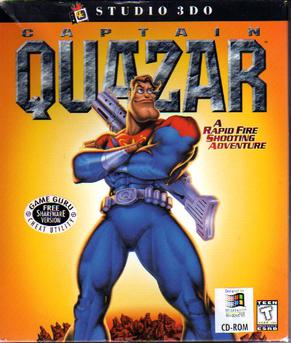
Captain Quazar is a science fiction third-person action game by developer Cyclone Studios, first published in 1996 by 3DO. Though initially released as an exclusive for 3DO's Interactive Multiplayer console, after the system was discontinued, Captain Quazar was ported to the Windows 95 PC platform in 1997.

Loaded is a science fiction-themed top-down multidirectional shooter developed by Gremlin Interactive and published by Interplay Productions. Loaded was released on December 15, 1995 on the PlayStation, and was ported to the Sega Saturn the following year. The game had origins in DC Comics as well as the more adult-orientated Vertigo Comics, and there was a small graphic novel based on the game. The six playable characters of the game are a combination of villains, anti-heroes, psychopaths, perverts, mutants, and flamboyant murderers. They are, however, the best hope to stop the intergalactic supervillain nicknamed F.U.B. and save the universe. The characters were created and designed with contributions from Garth Ennis of Vertigo Comics and Greg Staples of 2000AD.

Creature Shock is a 1994 sci-fi first-person shooter game released for MS-DOS and 3DO. It was developed by Argonaut Games and published by Virgin Interactive. The game was later ported to the CD-i, Sega Saturn and PlayStation video game systems.

Machine Hunter is a top-down shooter game developed by Eurocom Entertainment Software, published by MGM Interactive and distributed in Europe by Eidos Interactive. It was developed and released simultaneously in 1997 for Windows 95 and PlayStation console. It has been described as a clone of the 1995 game Loaded, in that it uses an overhead perspective, extensive lighting effects, and over-the-top bloodshed.
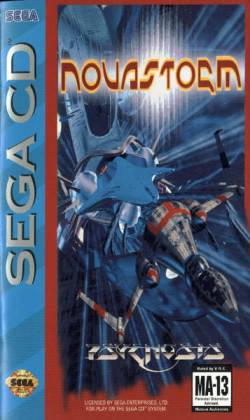
Novastorm is a rail shooter developed by Psygnosis in 1994. A version for the FM-Towns/Marty systems had previously been released under the name Scavenger 4.

Shockwave Assault is a science fiction combat flight simulation video game developed by Advanced Technology Group and published by Electronic Arts for various home video game consoles and PCs. The player takes control of a futuristic fighter plane to defeat extraterrestrial ships and tripods.

Lost Vikings 2 is a 1997 puzzle-platform game developed by Beam Software and published by Interplay. All versions of the game, except the SNES release, were titled Lost Vikings 2: Norse by Norsewest. The sequel to The Lost Vikings, it features the original three characters plus two new playable characters: Fang the werewolf and Scorch the dragon. The gameplay remains largely the same, though the three Viking characters all have new or modified abilities.

BattleSport is a 1996 futuristic sports video game developed by Cyclone Studios. It was originally published by Studio 3DO exclusively for their 3DO Interactive Multiplayer in 1996, but after the 3DO was discontinued BattleSport was published for other systems by Acclaim Entertainment. It was released for Windows and PlayStation in North America on June 30, 1997, and in Europe on August 1, 1997. It also saw a US only release on the Saturn.

ReBoot is a 1998 video game developed and published by Electronic Arts for the PlayStation video game console. It is based on the television show of the same name. The story follows Bob stopping Megabyte's plan to take over Mainframe through the use of energy tears. The game's creation began in 1995, when two representatives met and agreed on the idea. EA Canada spent over the next three years going through various technological meetings during the development cycle. ReBoot garnered mixed reviews from critics who were divided over the digital control, gameplay and graphics.

Top Gun: Fire at Will is a video game developed and published by Spectrum HoloByte for DOS, Windows, PlayStation, and Mac OS. It is a licensed game in the Top Gun franchise. A sequel, Top Gun: Hornet's Nest, was released in 1998.
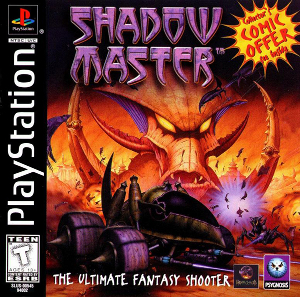
Shadow Master is a video game developed by HammerHead and published by Psygnosis for the PlayStation and Microsoft Windows. It is a first-person shooter in which the player character rides in an armed vehicle. It met with predominantly negative reviews which praised its visuals but criticized it for clunky controls and poorly designed, frustrating gameplay.
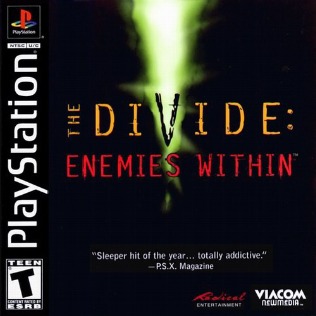
The Divide: Enemies Within is a 1996 action-adventure video game for the PlayStation and Windows.




















